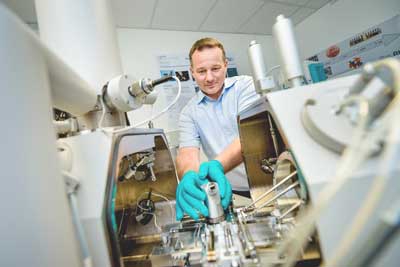| Posted: Oct 19, 2017 |
What tiny structures reveal about material properties
(Nanowerk News) Researchers at University Alliance Ruhr (UA Ruhr) explore in what way a material’s macroscopic properties are determined by its microstructure. The team from Bochum, Dortmund and Duisburg-Essen has developed a model that is capable of predicting the respective material’s behaviour during forming based on its microstructure, for example if it is extremely flexible or if it can be formed evenly throughout. A report on the project has been published by the Ruhr-Universität Bochum’s science magazine Rubin.
|
|
Forming processes are the industry’s bread-and-butter business. In models existing to date for describing the relevant processes, the microstructure of a material are not taken into consideration. Such models have to be painstakingly fed with parameters for each new material or microstructure that has been newly developed. This is supposed to change thanks to the new model that is being developed by the team collaborating in the “Materials Chain” research network at UA Ruhr.
|
|
The material forming project is a collaboration between Prof Dr Alexander Hartmaier from the Interdisciplinary Center for Advanced Materials Simulation in Bochum, Prof Dr Jörg Schröder from the Institute of Mechanics in Duisburg-Essen and Prof Dr Dr Erman Tekkaya from the Institute of Forming Technology and Lightweight Components in Dortmund, funded by the Mercator Research Center Ruhr.
|
 |
| Alexander Hartmaier prepares a sample for electron backscatter diffraction measurements. This method enables the engineers to identify the microstructure of a sample.
|
In the micrometre range
|
|
The researchers study materials, for example steel, in the range of several micrometres. Rather than being evenly textured, they are made up of grains in different sizes. These grains might also differ in terms of their crystal structure. In the first step, the researchers analyse the microstructure of a material in experiments; subsequently, they compile a virtual representation at the computer. “Today, all this is just a click away,” says Bochum-based engineer Napat Vajragupta.
|
|
Based on the virtual microstructure, the model can predict how the material will behave when it is subjected to different forces; for example when it is compressed or pulled apart. When simulating forming processes, the engineers pay particular attention to the way the material deforms in different spatial directions, and to the spots where springback occurs. Depending on the direction from which lateral pressure is applied to the crystal structure, the material deforms more or less strongly.
|
Customising materials
|
|
The engineers’ second objective is to reverse this model: they want to create customised materials with a specific application in mind. Once the necessary properties of a material have been identified, it will be possible to predict the microstructure required for this purpose.
|

